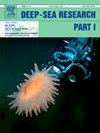The trapping of Agulhas Rings in the South Brazil Bight
IF 2.1
3区 地球科学
Q2 OCEANOGRAPHY
Deep-Sea Research Part I-Oceanographic Research Papers
Pub Date : 2025-03-20
DOI:10.1016/j.dsr.2025.104486
引用次数: 0
Abstract
The South Brazil Bight is a section of the Brazilian margin mainly dominated by the poleward Brazil Current flow, its meanderings and eddies. We evaluated the mean mesoscale activity for the region, and an anticyclonic feature was highlighted over the São Paulo Plateau. Around that feature, cyclonic eddies were also accentuated. The combination of these structures dominate the region, forming an eddy corridor. Using eddy detection dataset, we reveal that the filtered positive--signal on the plateau was related to the presence of anticyclones. The cyclones in the region originate both locally and remotely, whereas most anticyclones predominantly have remote origins. More than 95% of these anticyclones were Agulhas Rings, which could or could not have been subjected to splitting or merging processes. On the plateau we observe an average of 5.3 anticyclones per year. However, this rate is related not only to the number of anticyclones but also to the time they remain there. We observe that Agulhas Rings reside individually in the region for 50.8 days on average, consequently, they occupy the plateau for almost 75% of the year. During half of the residence time, there is a multi-pattern interaction with cyclonic eddies. This relationship between eddies of opposite polarity creates a shielding process. The anticyclones become shielded and trapped by the cyclones, have their progress delayed, and their course deflected towards the Brazil Current.
南巴西湾阿古拉斯环的捕获
南巴西湾是巴西边缘的一部分,主要由向极地流动的巴西洋流主导,它的蜿蜒曲折和漩涡。我们评估了该地区的平均中尺度活动,并在圣保罗高原上强调了一个反气旋特征。在那个特征周围,气旋漩涡也被强化了。这些结构的组合主导了该地区,形成了一个涡流走廊。利用涡旋检测数据,我们发现高原上的过滤阳性-Ψ-signal与反气旋的存在有关。该地区的气旋起源于本地和远程,而大多数反气旋主要起源于远程。这些反气旋中有95%以上是阿古拉斯环,它们可能经历过分裂或合并过程,也可能没有。在高原上,我们平均每年观察到5.3次反气旋。然而,这个速率不仅与反气旋的数量有关,还与它们在那里停留的时间有关。我们观察到,阿古拉斯环在该地区单独存在的时间平均为50.8天,因此,它们占据了高原近75%的时间。在一半的停留时间内,与气旋涡旋存在多模式相互作用。相反极性的涡流之间的这种关系产生了屏蔽过程。反气旋被气旋屏蔽和困住,其前进被延迟,其航线转向巴西洋流。
本文章由计算机程序翻译,如有差异,请以英文原文为准。
求助全文
约1分钟内获得全文
求助全文
来源期刊
CiteScore
4.60
自引率
4.20%
发文量
144
审稿时长
18.3 weeks
期刊介绍:
Deep-Sea Research Part I: Oceanographic Research Papers is devoted to the publication of the results of original scientific research, including theoretical work of evident oceanographic applicability; and the solution of instrumental or methodological problems with evidence of successful use. The journal is distinguished by its interdisciplinary nature and its breadth, covering the geological, physical, chemical and biological aspects of the ocean and its boundaries with the sea floor and the atmosphere. In addition to regular "Research Papers" and "Instruments and Methods" papers, briefer communications may be published as "Notes". Supplemental matter, such as extensive data tables or graphs and multimedia content, may be published as electronic appendices.

 求助内容:
求助内容: 应助结果提醒方式:
应助结果提醒方式:


